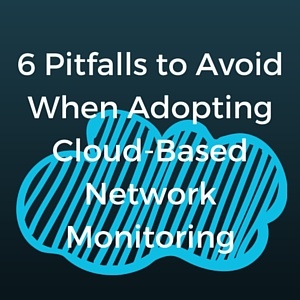So you’ve committed to a cloud-based network monitoring solution, and you’re ready to start implementation. Stop! As great as the advantages afforded by such may be, there are nonetheless a multitude of ways you can trip over your feet with your adoption of cloud applications. Make sure you’re aware of these common problems and pitfalls, and take steps to avert them before you fall headfirst into one.
1) Buy-in failure
With any new technology, application, or solution, achieving adequate buy-in from the people above and below you in the company should be your highest priority. Fail to do so, and every inadequacy, error, and headache will be blamed on the technology. If you want your cloud-based network monitoring to succeed, you need to be certain that you’re hearing complaints and offering solutions. You need people to work with the system rather than around it. Otherwise, you won’t be in any position to properly address problems and raise efficiency.
2) Lack of granularity in billing
Economy of scale plays a big role in making cloud-based solutions a financially superior option. Make sure you’re being billed in a way that recognizes this efficiency. If you’re paying for unused features or down time, if your costs are as high as companies leveraging support and other amenities twenty times as often as your company, then something has gone wrong. Pay for what you use.
3) Performance issues
Performance issues which arise from cloud-based network monitoring usually occur due to a failure to plan ahead. Identify all the devices which need to be monitored for your company, then communicate with your solution provider to affirm the solution’s ability to handle that number with the configuration you’ve chosen. Larger organizations or those with a multitude of devices may need special arrangements, such as solutions with onsite technology that can scale horizontally.
4) Unclear lines of responsibility
Make sure everyone involved knows who to contact if something goes awry with the new system. You don’t want to develop major choke points in support and waste the inherent efficiency of your new cloud-based system. Clarify responsibility and contacts for the new system and you’ll skip a lot of growing pains.
5) Security
It’s crucial that you assess the way a cloud-based network monitoring solution interacts with your existing security policies and necessities before implementation. An after-the-fact piecemeal approach to sealing security gaps simply isn’t acceptable for most organizations, nor will it work nearly as well as a focused, detailed redesign of policy. You’ll also need to clearly communicate any changes to anyone affected.
6) Tuning failures
Failing to tune your existing solutions on-site or your new cloud solution can and will result in inefficiency and errors. Your new monitoring solution may do the same things as your old on-site solution, but there are plenty of differences in execution. Identify them, and make sure everything on both ends works smoothly in concert.
Final thoughts
While there may be other troubles awaiting you, avoiding these will ensure a minimum of disruption, lost potential, and headache during implementation of your new solution. Resist any inclination to treat cloud-based applications as a perfect godsend devoid of flaws and you’ll find you get far greater results in the end.


